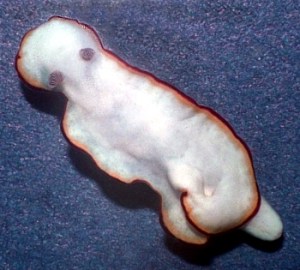

Chromodoris verrieri
(Crosse, 1875)
Order: NUDIBRANCHIA
Suborder: DORIDINA
Superfamily: EUDORIDOIDEA
Family: Chromodorididae
DISTRIBUTION
Indo-West Pacific
PHOTO
UPPER: Bongoyo Is, Dar es Salaam, Tanzania, November, 1976. 17mm long alive. [note malformed mantle at posterior end] Photo: Bill Rudman.
LOWER: Kerama Is.,near Okinawa, 5m depth, 6mm long. Photo: Atsushi Ono.
White mantle with an outer red and an inner yellow border. The rhinophore clubs are translucent red with a white edging to the lamellae, and the gills are translucent white (sometimes with a reddish tinge) and with opaque white pigment edging the lamellae. The foot is white. There are a group of similarly coloured species which are essentially white with red and yellow, or red, yellow and white mantle borders.
Reference:
• Rudman, W.B. (1985) The Chromodorididae (Opisthobranchia: Mollusca) of the Indo-West Pacific: Chromodoris aureomarginata, C. verrieri and C. fidelis colour groups. Zoological Journal of the Linnean Society, 83: 241-299.
Rudman, W.B., 2000 (June 28) Chromodoris verrieri (Crosse, 1875). [In] Sea Slug Forum. Australian Museum, Sydney. Available from http://www.seaslugforum.net/find/chroverr
Related messages
Chromodoris verrieri from NE Bali, Indonesia
July 10, 2007
From: Lindsay Warren
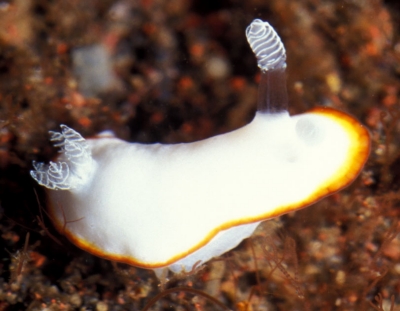

Dear Bill
Another locality record for a species already featured on the Forum. This time, two specimens of what I believe to be Chromodoris verrieri. They were found at two different locations.
Locality: Upper photo: Noisy Reef, Tukad Dabu, 24 ft / 7.2 m, NE Bali, Indonesia, Tropical Western Pacific, 10 May 2006 at 10:20, Silty covered rock in low growth reef area. Length: 8 mm. Lower photo: Coral Garden, Tulamben, NE Bali, Indonesia. Tropical Western Pacific, D: 17 ft / 5.1 m. Specimen length: 18 mm. Date: 15 May 2006 at 17:26. Moving over a rubbly area within gently sloping area of reef.
Photos: Lindsay Warren.
However on reading through the information on Noumea subnivalis Baba, 1937 I think the animal in the lower images could in fact be N. subnivalis rather than C. verrieri - the marginal band appears to gradually change from red through orange to yellow and there appear to be short conical pustules on the notum. I realise that the rhinophore clubs do not appear as dark red as the ones posted previously but the it could be a minor variation in the species. I realise that N. subnivalis has only been recorded in Japan so far but perhaps it has a wider distribution. However, given that it appears to grow to at least 30 mm, it would be surprising that no adults have been spotted in Bali before, particularly since Tulamben is so heavily dived by opistho afficionados!
Looking forward to hearing your views.
All the best
Lindsay Warren
lwarren@datonomy.co.uk
Warren, L.C.R., 2007 (Jul 10) Chromodoris verrieri from NE Bali, Indonesia. [Message in] Sea Slug Forum. Australian Museum, Sydney. Available from http://www.seaslugforum.net/find/19182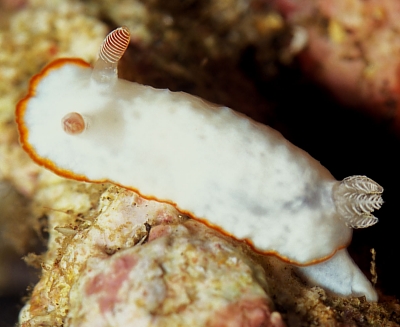
Dear Lindsay,
I'm afraid this group of chromodorids can be a little difficult, and I suspect to be really certain, some species should be examined anatomically. One example is Chromodoris albonares which is what I suspect your upper photo might be, but I am not sure. The white oversized rhinophores, with no trace of red, and the uniformly white mantle with no translucent mottling are two good characters of this species. One difficulty though is that the size of the rhinophores, disproportionally large for the size of the animal, are what most juveniles of other species look like, so when you see a small animal with large rhinophores you have to decide with few external clues, whether you have an adult C. albonares or a juvenile of another species.
Concerning N. subnivalis, I am afraid that I am not sure that all the photos identified as that species on the Forum are correctly identified. All I can really say is I think your second animal is C. verrieri. I know that doesn't make it easy for you to identify new finds, but its better to know it may be impossible to do so without an internal examination than to confidently misidentify them. Hopefully, as time goes by, we will find biological differences - perhaps egg ribbon colour and shape, or different food sponges - which will make field observations easier, but it becomes a bit of a vicious circle - when you find one laying an egg ribbon or eating a sponge, which one is it?
Best wishes,
Bill Rudman
Chromodoris verrieri from Indonesia
June 18, 2007
From: Ken Tucker

I've attached a photo of what must surely be Chromodoris verrieri. There has been another posted from the Wakatobi area of Indonesia. This one is from Lembeh Strait.
Locality: Lembeh Strait - Hairball II, 10 metres, Indonesia, Sulawesi, 24 Nov 2006. Length: 3 cm. Photographer: Ken Tucker.
Ken Tucker
ken@kilili.com
Tucker, K., 2007 (Jun 18) Chromodoris verrieri from Indonesia. [Message in] Sea Slug Forum. Australian Museum, Sydney. Available from http://www.seaslugforum.net/find/19372Thanks Ken,
Best wishes,
Bill Rudman
Re: Chromodoris verrieri? from Oman
March 21, 2007
From: Binyamin Koretz
Concerning message #19690:
Dear Bill,
The type of animal in Brian's and Oren's messages is commonly seen here in Eilat. You can see photos of 16 different individuals at http://www.koretz.net/Eilat/Invertebrates/Molluscs/Nudibranchs/Cverrieri.htm and they all have brown speckling on the mantle and broken or nearly broken yellow lines inside the red margin. Even tiny juveniles. But the red margin is always solid (unlike C. alius ) and there is no outer white margin (unlike C. preciosa ). We always just assumed that it was C. verrieri.
best regards
Binyamin
binyamin@koretz.net
Koretz, B., 2007 (Mar 21) Re: Chromodoris verrieri? from Oman. [Message in] Sea Slug Forum. Australian Museum, Sydney. Available from http://www.seaslugforum.net/find/19715Thanks Binyamin,
It certainly seems to be a consistent pattern - and consistently different, as you mention, from other similarly coloured species. We should add C. trimarginata and C. sinensis to the list as well. It looks like this is another of the many puzzles still to be sorted out
Best wishes,
Bill Rudman
Chromodoris verrieri? from Oman
March 20, 2007
From: Brian Mayes

Dear Bill,
Here are some photos of Chromodoris verrieri from the Gulf of Oman. I found it at a dive site called "Decorator Bay" in Bandar Khairan, near Muscat, Oman.
Locality: "Decorator Bay" in Bandar Khairan, near Muscat, 15 metres, Oman, Gulf of Oman, 01 March 2007, Silty reef. Length: 20 mm. Photographer: Brian Mayes.
It was in a hurry to get somewhere fast and covered quite a bit of ground while I photographed it. I'm not sure how common these are in this region, but hopefully it will add to your database
Best Regards
Brian Mayes
brian@mayescai.freeserve.co.uk
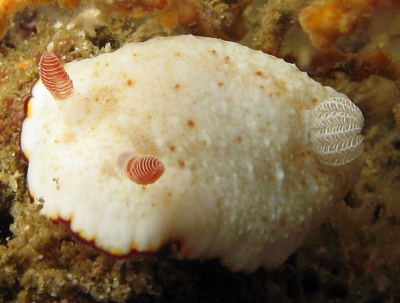
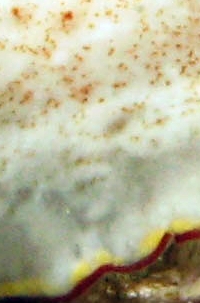
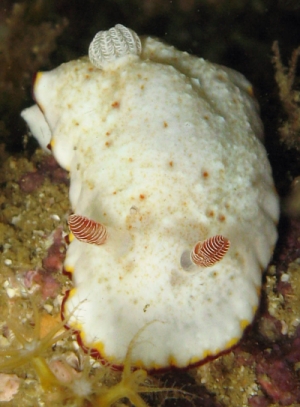
Dear Brian,
Thanks for this. It is very similar to a specimen from the Red Sea that Oren Lederman has sent us [message #13211]. I suggested then that it was strange to have a C. verrieri with a the yellow inner marginal band broken into a series of spots. Even more unusual was the brown spotting on the mantle, the larger spots each being in a translucent zone lacking white pigmentation, more reminiscent of C. preciosa. Your animal is much the same, and I am beginning to doubt that it is C. verrieri, but in C. preciosa there is a distinct white margin outside the red and yellow bands.
Another similarity is Chromodoris alius, which has an almost identical brownish spotting on the mantle. It differs in having a purple rather than a red border. I'll leave your animal as C. verrieri, but I somehow doubt it is that species.
Best wishes,
Bill Rudman
Chromodoris verrieri from Reunion island
April 25, 2006
From: Philibert Bidgrain

Dear Bill,
Reunion Island sea slugs.
In November I observed 3 specimens of this species in a rocky coast at Etang sale les bains (Reunion Island), and since two weeks I found in the same coast two other specimens. All the specimens have the same size (about 10 mm) and exactly the same external pattern. They look like C. albonares, but you say in your forum they are known from northern New South Wales and New Caledonia and reported in Forum from American Samoa. Do you think it's an Indian ocean C albonares??
Locality: etang sale les bains, 1m, Reunion island, Indian ocean, April 2006, intertidal rocky coast. Length: 8 to 10 mm. Photographer: Philibert Bidgrain.
Best Regards
Philibert Bidgrain
http://vieoceane.free.fr/runseaslug/indexslug.htm
pbidgrain@yahoo.fr
Bidgrain, P., 2006 (Apr 25) Chromodoris verrieri from Reunion island . [Message in] Sea Slug Forum. Australian Museum, Sydney. Available from http://www.seaslugforum.net/find/16411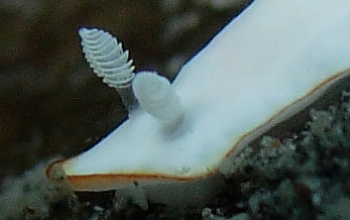
Dear Philibert,
The two colour bands around the mantle edge, yellow and red, make me suspect these are Chromodoris verrieri. I realise there is no reddish tinge on the rhinophores but 10 mm is still quite small for that species. Similarly, the relatively large rhinophores may also be a juvenile feature. I m afraid there is no easy way to distinguish adult C. albonares which are small when adult, but have relatively large rhinophores, from juveniles of other chromodorids.
Best wishes,
Bill Rudman
Juvenile Chromodoris from Pulau Tioman
March 9, 2006
From: Lillian Danielle Khoo
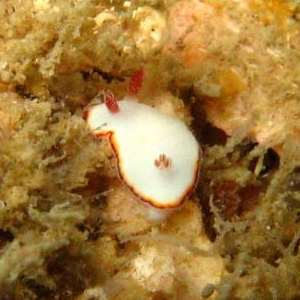
Took this at depth of 22 m - 24 m at Soyak Wreck in Pulau Tioman. Approximate size is about 5 mm. Can someone help me identify the species?
Locality: Soyak, Pulau Tioman, 24 m, Malaysia, South China Sea, 27 February 2006. Length: 5 mm. Photographer: Lillian Danielle Khoo.
Thank you.
Regards,
Lillian Danielle Khoo
wiccanlilly@hotmail.com
Khoo, L.D., 2006 (Mar 9) Juvenile Chromodoris from Pulau Tioman. [Message in] Sea Slug Forum. Australian Museum, Sydney. Available from http://www.seaslugforum.net/find/16045Dear Lillian,
Its a bit difficult to be sure of juveniles but I am pretty confident that this is Chromodoris verrieri.
Best wishes,
Bill Rudman
Are these juveniles of Chromodoris verrieri??
August 17, 2005
From: Andre Couture
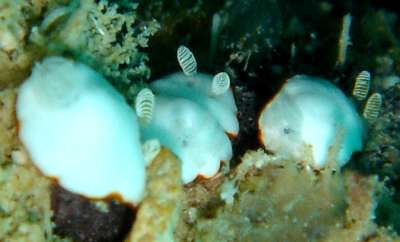
Hi,
I have found these 4 tiny (+- 4mm) nudibranchs in Yap in about 15m of water.
Locality: Goofnuw Channel, Yap Is. Pacific. Depth: 15 m. Length: 4 mm. 31 July 2005. natural channel. Photographer: Andre Couture
I have look in Debelius book on Nudi's and seem that it could be a Chromodoris verrieri but I have never seen the adult version in over 19 months of diving here.
Can someone confirm what kind it is exactly?
Thanks
Andre
andre@mantaray.com
Couture, A., 2005 (Aug 17) Are these juveniles of Chromodoris verrieri??. [Message in] Sea Slug Forum. Australian Museum, Sydney. Available from http://www.seaslugforum.net/find/14459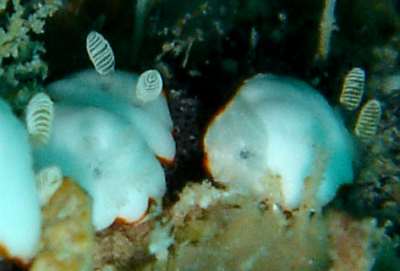
Dear Andre,
It's always difficult identifying juveniles, especially in a groupd like the chromodorids where their are a number of similarly coloured species to choose from. One real clue are the white edges to the rhinophores, which are found in only some of this colour group of chromodorids.
Chromodoris verrieri and Noumea subnivalis are two possibilities, and another is Chromodoris albonares which is characterised by having proportionally large rhinophores. Your animal has large rhinophores, but unfortunately proportionally large rhinophores are characteristic of all juvenile chromodorids so its not much of a clue in this case. As a guess I think Chromodoris verrieri is as good as any other.
Best wishes,
Bill Rudman
Chromodoris verrieri from Solomon Ids
April 20, 2005
From: Bruce Potter

Dear Bill,
I found this Chromodoris preciosa on a coral and rubble site just on the outskirts of Honiara Solomon Islands. It was about 8mm long and at about 13 meters.
Locality: Honiara, Solomon Islands, Pacific Ocean. Depth: 13 meters. Length: 8 mm. 10 January 2005. Coral, rubble, sand. Photographer: Bruce Potter
Regards
Bruce.
bandppotter@bigpond.com.au
Potter, B., 2005 (Apr 20) Chromodoris verrieri from Solomon Ids. [Message in] Sea Slug Forum. Australian Museum, Sydney. Available from http://www.seaslugforum.net/find/13526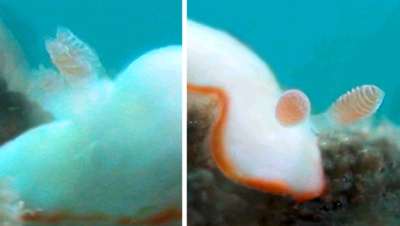
Dear Bruce,
It's hard to be sure with juveniles, but the red border seems to be right at the edge, which would suggest this is Chromodoris verrieri rather than C. preciosa.
Best wishes,
Bill Rudman
Chromodoris verrieri from the Red Sea
March 1, 2005
From: Oren Lederman
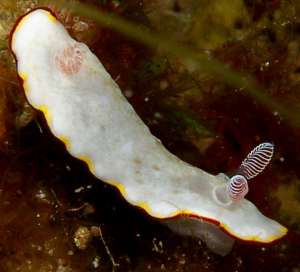
Hi Bill,
We couldn't identify this one.
Locality: "The Princess Beach", Eilat Bay, Israel, Red Sea. Depth: ~25 meters. Length: ~1-1.5 cm. 18 Feb 2005. Photographer: Oren Lederman.
Oren Lederman
lederman@bigmail.co.il
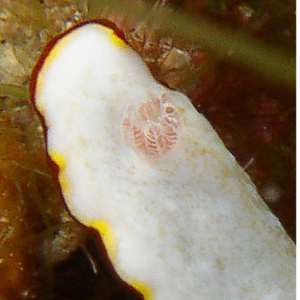
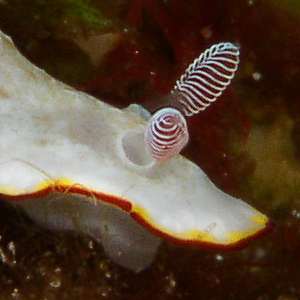
Dear Oren,
This is Chromodoris verrieri. It is interesting how in your animal, the yellow band around the mantle edge is broken into a series of elongate streaks. It is usually a continuous line. The white edged rhinophores and gills are characteristic of this species. Yonow (1989) reports a specimen from Eilat, but we certainly don't have many records of it from the Indian Ocean region.
-
Yonow, N. (1989) Red Sea opisthobranchia 2: The family Chromodorididae (Mollusca, Nudibranchia). Fauna of Saudi Arabia 10: 290-309.
Best wishes,
Bill Rudman
Chromodoris verrieri from Philippines
November 13, 2003
From: Yukari Sato

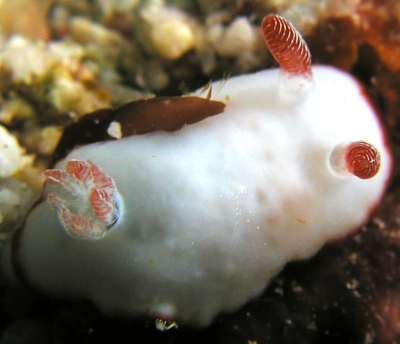
Hello Dr.Rudman,
I have found an pretty animal while my recent Philippines trip.
I guess this is Chromodoris verrieri.
Date: 20 Sep 2003
Size: approx. 10mm
Location: Lilo-an, Santander, Cebu Is, Philippines
Best regards,
Yukari Sato
yuks@cg7.so-net.ne.jp
Sato, Y., 2003 (Nov 13) Chromodoris verrieri from Philippines. [Message in] Sea Slug Forum. Australian Museum, Sydney. Available from http://www.seaslugforum.net/find/11365
Dear Yukari,
Yes I think this is Chromodoris verrieri, but I must say the inner colour band in the mantle border is much redder than normal. Usually it is yellow.
Best wishes
Bill Rudman
Chromodoris verrieri from Nelson Bay
March 17, 2003
From: Dave Harasti


Hi Bill,
I have attached another animal that I am unsure of its ID. The species was found at Little Beach, Nelson Bay, [Port Stephens, NSW, Australia] on the wharf pylons in November 2002.
I first thought it was Chromodoris daphne. but it is lacking the customary red spots on the body. I now think it is Chromodoris verrieri. Would this ID be correct?
Cheers,
Dave Harasti
diving@webone.com.au
Harasti, D., 2003 (Mar 17) Chromodoris verrieri from Nelson Bay. [Message in] Sea Slug Forum. Australian Museum, Sydney. Available from http://www.seaslugforum.net/find/9244Yes Des,
I think this is Chromodoris verrieri. It's not a common visitor down the New South Wales coast, but then it doesn't seem to be the most common species in its normal tropical haunts either.
Best wishes,
Bill Rudman
Chromodoris albonares? from Sulawesi
July 2, 2000
From: Lindsay Warren

Dear Bill
I was just looking through your species list at Chromodoris albonares which reminded me of a specimen I found in August 1998 (OWN48) off Pulau Hoga in the Tukang Besi Islands, SE Sulawesi [Operation Wallacea]. I have attached a picture taken by Adam Powell. At the time we thought it might be a juvenile Chromodoris
verrieri but on looking at C. albonares I think that this is a more likely identification. The most striking thing about it was the large lamellate
rhinophores which seemed 'outsized' for the length of body (5.5 mm). I found it at a depth of 8 ft on the reef crest crawling over a dead ark shell in a patch of sand. The gills were relatively small with a slightly
darker area to anterior portion which might have been internal organs showing through. Through the underside of the foot one could see a pale grey area.
What do you think?
All the best
Lindsay Warren
100014.2112@compuserve.com
Warren, L., 2000 (Jul 2) Chromodoris albonares? from Sulawesi. [Message in] Sea Slug Forum. Australian Museum, Sydney. Available from http://www.seaslugforum.net/find/1849Dear Lindsay,
Your first thought was correct. C. albonares only has a single colour band ( of orange-yellow) around the mantle edge. It does have disproportionally large rhinophores but that appears to be one of its distinguishing features. Usually, as in your photo, chromodorids with large rhinophores are juveniles. At 5mm your animal is definitely a juvenile C verrieri, which is distinguished by the red and yellow borders, and the white-edged gills and rhinophores. I don't think the lack of a reddish background to the rhinophore clubs is of great significance. It appears to be an internal colouration which is sometimes present and sometimes not.
Best wishes,
Bill Rudman.
Chromodoris verrieri from Kerama Is
June 29, 2000
From: Atsushi Ono


Dear Bill,
Thank you very much for your comment on Chromodoris alius.
Here is an animal looks a bit similar to Thorunna furtiva but I think this is different species. These rhinophore stalks are translucent and the clubs are light orange with white edgings. At the mantle edge is a band of dark red and inside this a submarginal band of orange-yellow.
This small beauty is 6mm long, found at 5m depth, at Kerama Is., near Okinawa.
Could you help me to identify this for me?
Sincerely,
Atsushi Ono
ononini@cosmos.ne.jp
Atsushi Ono, 2000 (Jun 29) Chromodoris verrieri from Kerama Is. [Message in] Sea Slug Forum. Australian Museum, Sydney. Available from http://www.seaslugforum.net/find/2631Dear Atsushi,
Your small 'beauty' is a juvenile of Chromodoris verrieri which is found throughout the tropical Indo-West Pacific.
The only photo of an adult I can find is the one I have put at the top of the page from Tanzania with a very strange malformation to the mantle. Another one to add to the list on the Growth abnormalities Page.
There are a number of species with very similar colour patterns to Chromodoris verrieri which I will try an add to the Forum in the near future including, Chromodoris trimarginata, Chromodoris preciosa, Chromodoris sinensis,Chromodoris rubrocornuta and Chromodoris galactos.
Best wishes,
Bill Rudman.
